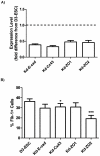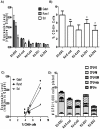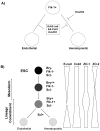Differential adhesion molecule expression during murine embryonic stem cell commitment to the hematopoietic and endothelial lineages
- PMID: 21909405
- PMCID: PMC3167810
- DOI: 10.1371/journal.pone.0023810
Differential adhesion molecule expression during murine embryonic stem cell commitment to the hematopoietic and endothelial lineages
Abstract
Mouse embryonic stem cells (ESC) make cell fate decisions based on intrinsic and extrinsic factors. The decision of ESC to differentiate to multiple lineages in vitro occurs during the formation of embryoid bodies (EB) and is influenced by cell-environment interactions. However, molecular mechanisms underlying cell-environmental modulation of ESC fate decisions are incompletely understood. Since adhesion molecules (AM) influence proliferation and differentiation in developing and adult tissues, we hypothesized that specific AM interactions influence ESC commitment toward hematopoietic and endothelial lineages. Expression of AM in the adherens, tight and gap junction pathways in ESC subpopulations were quantified. E-cadherin (E-cad), Claudin-4 (Cldn4), Connexin-43 (Cx43), Zona Occludens-1 (ZO-1) and Zona Occludens-2 (ZO-2) transcript levels were differentially expressed during early stages of hematopoietic/endothelial commitment. Stable ESC lines were generated with reduced expression of E-cad, Cldn4, Cx43, ZO-1 and ZO-2 using shRNA technology. Functional and phenotypic consequences of modulating AM expression were assessed using hematopoietic colony forming assays, endothelial sprouting assays and surface protein expression. A decrease in E-cad, Cldn4, Cx43 and ZO-1 expression was associated with less commitment to the hematopoietic lineage and increased endothelial differentiation as evidenced by functional and phenotypic analysis. A reduction in ZO-2 expression did not influence endothelial differentiation, but decreased hematopoietic commitment two-fold. These data indicate that a subset of AM influence ESC decisions to commit to endothelial and hematopoietic lineages. Furthermore, differentially expressed AM may provide novel markers to delineate early stages of ESC commitment to hematopoietic/endothelial lineages.
Conflict of interest statement
Figures






Similar articles
-
Liver sinusoidal endothelial cells promote lymphohematopoietic differentiation from murine embryonic stem cells: role of soluble factors.Immunol Lett. 2014 Sep;161(1):106-12. doi: 10.1016/j.imlet.2014.04.017. Epub 2014 Jun 2. Immunol Lett. 2014. PMID: 24892988
-
Liver sinusoidal endothelial cells support the survival and undifferentiated growth of the CGR8 mouse embryonic stem cell line: possible role of leukemia inhibitory factor (LIF).Cytokine. 2011 Dec;56(3):608-15. doi: 10.1016/j.cyto.2011.08.035. Epub 2011 Sep 17. Cytokine. 2011. PMID: 21930391
-
RUNX1a enhances hematopoietic lineage commitment from human embryonic stem cells and inducible pluripotent stem cells.Blood. 2013 Apr 11;121(15):2882-90. doi: 10.1182/blood-2012-08-451641. Epub 2013 Jan 31. Blood. 2013. PMID: 23372166 Free PMC article.
-
Hematopoietic cell differentiation from embryonic and induced pluripotent stem cells.Stem Cell Res Ther. 2013 Jun 18;4(3):71. doi: 10.1186/scrt222. Stem Cell Res Ther. 2013. PMID: 23796405 Free PMC article. Review.
-
Dissecting hematopoietic differentiation using the embryonic stem cell differentiation model.Int J Dev Biol. 2010;54(6-7):991-1002. doi: 10.1387/ijdb.103065th. Int J Dev Biol. 2010. PMID: 20711977 Review.
Cited by
-
YY1 Positively Regulates Transcription by Targeting Promoters and Super-Enhancers through the BAF Complex in Embryonic Stem Cells.Stem Cell Reports. 2018 Apr 10;10(4):1324-1339. doi: 10.1016/j.stemcr.2018.02.004. Epub 2018 Mar 1. Stem Cell Reports. 2018. PMID: 29503092 Free PMC article.
-
Engineering three-dimensional stem cell morphogenesis for the development of tissue models and scalable regenerative therapeutics.Ann Biomed Eng. 2014 Feb;42(2):352-67. doi: 10.1007/s10439-013-0953-9. Epub 2013 Dec 3. Ann Biomed Eng. 2014. PMID: 24297495 Free PMC article. Review.
-
Label-free enrichment of adrenal cortical progenitor cells using inertial microfluidics.PLoS One. 2012;7(10):e46550. doi: 10.1371/journal.pone.0046550. Epub 2012 Oct 4. PLoS One. 2012. PMID: 23056341 Free PMC article.
-
Craniofacial reconstruction with induced pluripotent stem cells.J Craniofac Surg. 2012 May;23(3):623-6. doi: 10.1097/SCS.0b013e318252f41b. J Craniofac Surg. 2012. PMID: 22627398 Free PMC article.
References
-
- Dzau VJ, Gnecchi M, Pachori AS, Morello F, Melo LG. Therapeutic Potential of Endothelial Progenitor Cells in Cardiovascular Diseases. Hypertension. 2005;46:7–18. - PubMed
-
- D.o.H.a.H.S. Hematopoietic Stem Cells. Stem Cells: Scientific Progress and Future Research Directions; 2001.
-
- Mimeault M, Hauke R, Batra SK. Stem Cells: A Revolution in Therapeutics - Recent Advances in Stem Cell Biology and Their Therapeutic Applications in Regenerative Medicine and Cancer Therapies. Nature. 2007;82:252–264. - PubMed
-
- Ling V, Neben S. In vitro differentiation of embryonic stem cells: immunophenotypic analysis of cultured embryoid bodies. J Cell Physiol. 1997;171:104–115. - PubMed
-
- Keller G. Embryonic stem cell differentiation: emergence of a new era in biology and medicine. Genes Dev. 2005;19:1129–1155. - PubMed
Publication types
MeSH terms
Substances
LinkOut - more resources
Full Text Sources
Medical
Miscellaneous

